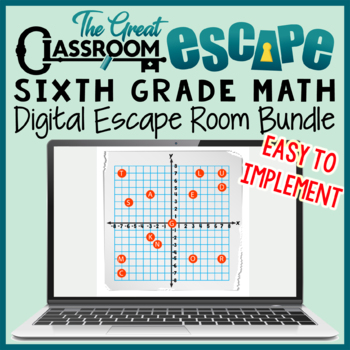6th Grade Math Digital Escape Room Bundle Fun & Engaging Practice & Review
- Zip
- Google Apps™
- Easel Activity

What educators are saying
Products in this Bundle (16)
showing 1-5 of 16 products
Description
Give students a fun and engaging way to practice and review 6th grade math skills with these challenging digital escape rooms! All of these activities are self-checking, little to no prep, and fully automated by Google Forms™. They can be used by anyone with an internet connected device (you do NOT need Google™ accounts to use these online breakouts).
Sixth Grade Math Escape Rooms Included (please view previews and information for each product to see the specific standards addressed):
- Practice rates and ratios skills escaping Horatio's Haunted House
- Escape Polly's Pizza with knowledge of the area of triangles and composite shapes (two difficulty levels provided)
- Review order of operations with exponents as you catch a criminal
- Stop a computer virus in an engaging percent escape room
- Escape the bunker by creating equivalent fractions by combining like terms, factoring, and distributing.
- Factor and distribute to break out of a factory in a fun expressions & equations digital escape room
- Save the rocket launch in a Quick Escape involving reading, writing & evaluating expressions
- Escape Antarctica by flexing your absolute value and negative number skills
- Break out of the museum with statistics and probability problems
- Foil a diamond heist by plotting points and solving problems in all four quadrants of the coordinate plane
- Escape from Mars with GCF and LCM. The launch window is about to close and your students need to find the emergency escape rocket!
- Prepare the recording studio by writing, testing, and graphing inequalities.
- Translating and evaluating expressions will lead students to the treasure of the Mayan temple.
- Free the Yeti by dividing fractions and mixed number.
- Help the alien family escape Area 51 by finding the areas of triangles, trapezoids, parallelograms, and composite shapes.
What is included in the PDFs?
- Easy to follow instructions
- Details for implementing this product for remote/distance learning (including the option to save a copy of the Google Form™ to your own drive
- Detailed answer key
- Teacher Tips
- Some escape rooms include optional recording page for students to show their work, write equations, and work out some of the puzzles.
- Optional success signs to snap a photo with to celebrate escaping!
- Three of these escape rooms also offer printable versions
FAQ
- Do students need to have Gmail™ accounts? NO! Anyone with internet access and a tablet, computer, or even phone can complete the breakout. The escape room is automated by a Google Form™, but does not require the teacher or students to have Google™ accounts.
- How long will this take? That is the hardest question as the answer varies depending on each classroom, student, or group. Some students with a firm grasp on the concepts covered in this escape room will be able to complete the challenge very quickly (20 minutes), others will take longer. Allowing calculators to be used will make some of these activities much faster. The majority of students will take between 35-60 minutes. Requiring students to use the recording form will increase the amount of time required to complete the puzzles. The form will not save student data, so if you are worried about your students not finishing on time, simply have them write their answers on scratch paper. They can then come back and quickly re-enter their answers and pick up where they left off.
- Will students have to search the web to figure out the puzzles? NO! All of the information needed will be provided in the Google Form™. The math in this activity is all standards-based.
Escape rooms are great for reviewing before tests, providing enrichment, and encouraging collaboration and student engagement.
See all of our Fun & Engaging 6th Grade Math Activities
View all of our online escape rooms for distance or in-person learning





